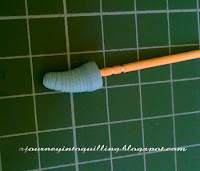To learn fast, read this tutorial in full to get an idea of the steps and concepts then read
it again while you follow the steps creating the item. Then try the item out
without looking at the tutorial and you will remember it without effort.
Tools That Are Useful
A toothpick sharpened with a blade is useful for rolling the pegs without large holes in the center. I sharpen it to increase friction so that I can turn the toothpick to roll the strip . Roll the toothpick over the end of the strip, applying a little pressure so that the strip rolls around the tip, then roll the strip around the sharpened end using thumb and forefinger. Once a portion of the strip is wound round the toothpick you can roll the toothpick to finish the peg and glue it. Ensure that you do not wind it too tightly. What is most important is the tension which should be neither too tight or too loose. If you find the inner coils are too tight allow a minute unwind and then glue it.
You will need to practice a bit if you are using a toothpick. You can even wind it with your fingers to complete the peg. The toothpick is only required to ensure the inner hole is small as in the pic below.
Now to shape it. Slightly concave the peg with the ball of your finger, then hold the peg between thumb and forefinger as shown.
Now press the peg a little and move your forefinger forward and backwards and as you do that, the peg will start cupping downwards.
Then move you fingers a tad lower on the cupped coil and repeat the action till about 1mm of each coil is visible.
If you want cones you can push the coils out with a narrow cylinder and the roll it clockwise slightly to tighten the coils.
Another point of note is the breadth of the strip. Thinner 1mm or 2mm strips make more rounded small objects while 4mm and over strips will make more cone shaped small objects.
Butterfly Body
If you want a cone shaped object which is rounded on top like in the pic for butterfly bodies, then youOr, you can keep the peg on a soft surface and push it with your finger to make a cup shape and then once the top is rounded you can gently push the bottom with a toothpick to make a shape resembling a funnel. Then you can elongate the rounded top slightly by rolling a cotton bud around the surface from the inside.
Curved Cone
The best way to learn is to make a few pegs and experiment how it shapes with various movements both on the inside and outside of the cones. You can always use molds or plastic palettes to make rounded shapes.
The use of cotton buds to shape has the advantage of allowing you to get any size by wrapping more cotton around it. The foam prevents the bottom from getting pushed out while rounding it.
Keep checking your coils to ensure that you have not pushed out any area too much and each coils exposes only half to 3/4ths of the breadth.
I hope this has been helpful. If it was, I would love to hear your comments.











Hey Christine ..You don't know how much I needed this.I could never make two cone exactly similar for making doll's arm,nor did they look proper.I did the rolling but for the tip when I used some pointed object the the inner coil would just come off.You are correct about even pressure while quilling tight coil too.I can't thank you enough for this tips ...still THANKS A LOT !!
ReplyDeleteHi Pooja, I too used to have heaps of messed up coils till I started using this method. Now I have more control of the shaping.
DeleteThis is very useful, thanks!
ReplyDeleteGorgeous!
ReplyDeleteThanks for sharing!
Thanks for the tutorial Chris :)
ReplyDeleteThanks for sharing the tutorial.
ReplyDeleteThanks Christine for explaining in detail, I use empty refills, sharpened pencils, small metal rods from my kids builder sets and tiny pins to shape coils!!
ReplyDeletehttp://www.kalasirjana.blogspot.in/
This is so helpful! Thanks so much!
ReplyDelete